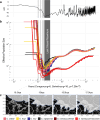Origin of the Laurentian Great Lakes fish fauna through upward adaptive radiation cascade prior to the Last Glacial Maximum
- PMID: 39134631
- PMCID: PMC11319351
- DOI: 10.1038/s42003-024-06503-z
Origin of the Laurentian Great Lakes fish fauna through upward adaptive radiation cascade prior to the Last Glacial Maximum
Abstract
The evolutionary histories of adaptive radiations can be marked by dramatic demographic fluctuations. However, the demographic histories of ecologically-linked co-diversifying lineages remain understudied. The Laurentian Great Lakes provide a unique system of two such radiations that are dispersed across depth gradients with a predator-prey relationship. We show that the North American Coregonus species complex ("ciscoes") radiated rapidly prior to the Last Glacial Maximum (80-90 kya), a globally warm period, followed by rapid expansion in population size. Similar patterns of demographic expansion were observed in the predator species, Lake Charr (Salvelinus namaycush), following a brief time lag, which we hypothesize was driven by predator-prey dynamics. Diversification of prey into deep water created ecological opportunities for the predators, facilitating their demographic expansion, which is consistent with an upward adaptive radiation cascade. This study provides a new timeline and environmental context for the origin of the Laurentian Great Lakes fish fauna, and firmly establishes this system as drivers of ecological diversification and rapid speciation through cyclical glaciation.
© 2024. The Authors. Parts of this work were authored by US Federal Government authors and are not under copyright protection in the US; foreign copyright protection may apply.
Conflict of interest statement
The authors declare no competing interests.
Figures


Similar articles
-
Environmental correlates of adaptive diversification in postglacial freshwater fishes.J Fish Biol. 2024 Mar;104(3):517-535. doi: 10.1111/jfb.15621. Epub 2023 Dec 10. J Fish Biol. 2024. PMID: 37984834 Review.
-
Application of machine learning to identify predators of stocked fish in Lake Ontario: using acoustic telemetry predation tags to inform management.J Fish Biol. 2021 Jan;98(1):237-250. doi: 10.1111/jfb.14574. Epub 2020 Nov 3. J Fish Biol. 2021. PMID: 33015862
-
Genetic relationships between sympatric and allopatric Coregonus ciscoes in North and Central Europe.BMC Ecol Evol. 2021 Oct 6;21(1):186. doi: 10.1186/s12862-021-01920-8. BMC Ecol Evol. 2021. PMID: 34615463 Free PMC article.
-
Genetic and phenotypic variation along an ecological gradient in lake trout Salvelinus namaycush.BMC Evol Biol. 2016 Oct 19;16(1):219. doi: 10.1186/s12862-016-0788-8. BMC Evol Biol. 2016. PMID: 27756206 Free PMC article.
-
The influence of changing climate on the ecology and management of selected Laurentian Great Lakes fisheries.J Fish Biol. 2010 Nov;77(8):1764-82. doi: 10.1111/j.1095-8649.2010.02759.x. Epub 2010 Oct 11. J Fish Biol. 2010. PMID: 21078089 Review.
References
-
- Simpson G. G. Tempo and mode in evolution. Columbia University Press (1944).
-
- Simpson, G. G. The baldwin effect. Evolution7, 110–117 (1953).10.2307/2405746 - DOI
-
- Schluter D. The ecology of adaptive radiation. OUP Oxford (2000).
-
- Reznick, D. & Endler, J. A. The Impact of Predation on Life History Evolution in Trinidadian Guppies (Poecilia reticulata). Evolution36, 160–177 (1982). - PubMed
Publication types
MeSH terms
Grants and funding
LinkOut - more resources
Full Text Sources

